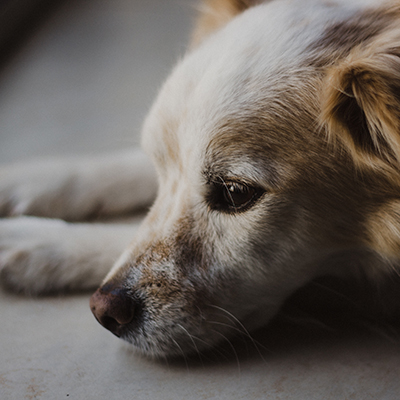Uncommon Ways Your Dog May Be Expressing His Anxiety
 You might know your dog is scared of thunderstorms, or fireworks, or strangers, but how can you tell what else might make your puppy scared or uncomfortable? Since your pup can’t share his deepest fears verbally, we have to learn to look for nonverbal cues. So what should you look for if you think your canine companion might be frightened?
You might know your dog is scared of thunderstorms, or fireworks, or strangers, but how can you tell what else might make your puppy scared or uncomfortable? Since your pup can’t share his deepest fears verbally, we have to learn to look for nonverbal cues. So what should you look for if you think your canine companion might be frightened?
Lip Licking
What you might take to be a sign of hunger or your dog salivating at a tasty treat may actually be a sign of anxiety. If he is flicking his tongue out rapidly and is not showing other signs of hunger such as begging, then his lip licking is likely a sign of fear.
Tail Wagging
Did you know that this behavior that we associate with happiness and excitement can sometimes be a dog’s response to fear? Tail wagging can be a dog’s response to over-stimulation. If you notice that your dog has his tail hung low and wagging by his legs, he is likely trying to demonstrate submission as a way to cope with fear.

Yawning
Just like with humans, scientists aren’t sure what the evolutionary purpose of a yawn is in dogs, but it can be something dogs do in stressful environments. In addition, if you notice your pup panting and then immediately closing his mouth, this could also signify that they have suddenly noticed something they are scared of.
Rolling over
This one is particularly tricky, as so many dogs do like their tummy rubbed, but at times dropping to their back and showing their tummies can be their way of showing submission when they are over-stimulated or frightened. The best way to tell what your dog is feeling here is to look at other cues—do they whine when you don’t immediately come to pet them or jump up only to flop back down? That is a puppy who wants his belly rubbed. Stillness or avoidance of eye contact signifies that this position might be a response to fear instead.
Scratching at doors or windows
All dogs like to scratch and bite, but it’s important to notice where their action is concentrated. A dog who is scratching at doors or windows has enough fear and anxiety that they are working to escape. This is a classic sign of separation anxiety but can also happen in environments that provide particular stressors for your pup.
Each of these behaviors is certainly context-dependent, but you and your dog will be better communicators when you recognize the ways your pup may be indicating stress.